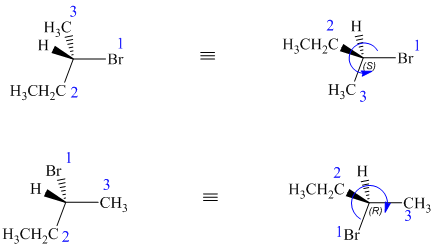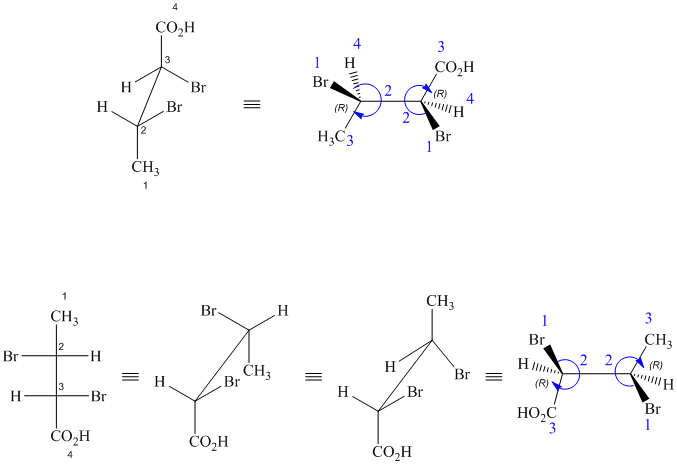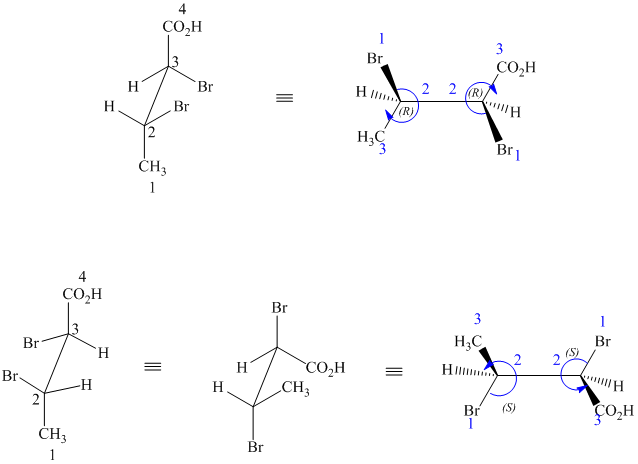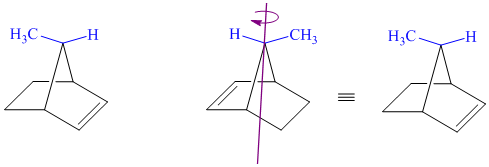
Concept explainers
Interpretation:
The relationship between the molecules in each pair is to be determined. Whether drawings represent constitutional isomers, stereoisomers, or just different ways of drawing the same compound is to be determined. If they are stereoisomers, it is to be determined if they are enantiomers or diastereomers.
Concept introduction:
Constitutional isomers are compounds with the same chemical formula but different connectivity.
Stereoisomers are compounds with the same chemical formula and connectivity but different spatial arrangement.
If a pair of stereoisomers forms an object and non-superimposable mirror image, then they are called enantiomers. Enantiomers contain a chiral center.
If a pair of stereoisomers does not have an object and its mirror image relation, then they are called diastereomers.
Identical molecules have the same absolute configuration at each chiral center.
Answer to Problem 38P
Solution:
a) These two structures are enantiomers.
b) These are different ways of drawing the same compound.
c) These structures are enantiomers.
d) These structures are constitutional isomers.
e) These are different ways of drawing the same compound.
f) These are different ways of drawing the same compound.
g) These structures are enantiomers.
h) These are diastereomers.
i) These structures are different ways of drawing the same compound.
j) These structures are different ways of drawing the same compound.
Explanation of Solution
a) The two given structures are as follows:

Both structures are chiral as four different atoms/groups attached to the central carbon. The absolute configurations at the chiral center for the two structures are determined from Cahn-Ingold-Prelog (CIP) system.

In both structures, the lowest priority group (H) is at the front. The structures are first rotated so that the hydrogen is at the back. The order of priority in the molecule is
In the first structure, the three highest ranking groups trace a counterclockwise path, giving an absolute configuration S.
In the second structure, the three highest ranking groups trace a clockwise path, giving an absolute configuration R.
Since the two structures have different absolute configurations, they are enantiomers.
b) The structures have a plane of symmetry, passing through the atoms (marked in blue) on the horizontal bonds. Rotating any one structure through

c) The two given structures are as follows:

Both the given structures contain one chiral center with identical substituents.
Based on CIP system, the order of priority of the groups attached to the chiral center is

In the first structure, the hydrogen is at the back. The three highest ranking groups trace a clockwise path, giving an absolute configuration of R.
The second structure first needs to be rotated around the horizontal axis so that the hydrogen is at the back. With this, the other three groups follow a counterclockwise path, giving an absolute configuration of S.

Since the two structures have different absolute configurations at the identical chirality centers, these are enantiomers of each other.
d) The two given structures are as follows:

In the first structure, the carbon atom to which the hydroxyl group is attached is numbered first
In the second structure, the carbon atom to which the hydroxyl group is attached is numbered first
In both the given structures, the position of the double bond is different. Thus, the given drawings represent two different compounds with the same molecular formula but with different connectivity of atoms. Thus, they are constitutional isomers of each other.
e) These structures are identical and show different ways of drawing the same compound.

The structures have a plane of symmetry, passing through
f) The given drawings are as follows:

These are different ways of drawing the same compound as shown below:

Both structures contain two chiral centers, at
Before comparing, the two structures are redrawn using wedge-dash bonds.
Following the CIP system shows that the two chiral centers in both structures have the same absolute configurations (2R, 3R). Therefore, they are identical and indicate different ways of drawing the same compound.
g) These structures are enantiomers.

The two drawings contain two chirality centers each. Absolute configurations at each chirality centers for these are shown below:

Both structures have two chiral centers,
Based on the CIP system, the absolute configurations of the two centers in the first structure are (2R, 3R).
The absolute configurations of the two centers in second structure are (2S, 3S).
As the absolute configurations at both the centers are changed, the structures are mirror images and therefore enantiomers.
h) These structures are diastereomers – cis-trans isomers.

Both structures have two chiral centers. However, they also have a plane of symmetry, one that contains the isopropyl group, iodine atom, and the ring carbons to which these are bonded. Because of this plane of symmetry, these are not chiral molecules; they are diastereomers.
Additionally the iodine atom has different orientations in the two structures with respect to the isopropyl substituent. In the first structure, it is in the equatorial position, and in the second structure it is in the axial position. The isopropyl group is in the equatorial position in both. As a result, the isopropyl group and iodine are trans to each other in the first structure. They are cis to each other in the second structure.
Therefore, these two structures are diastereomers and show cis-trans isomerism.
i) The given pair of compounds are as follows:

In the first structure, the double bonded carbon atoms are
j) These structures are different ways of drawing the same compound.

Rotating one of the structures through
Want to see more full solutions like this?
Chapter 4 Solutions
Organic Chemistry - Standalone book
- Homework 13 (Ch17) Question 4 of 4 (1 point) | Question Attempt: 2 of 2 ✓ 1 ✓ 2 = 3 4 Time Remaining: 4:25:54 Using the thermodynamic information in the ALEKS Data tab, calculate the standard reaction free energy of the following chemical reaction: 2CH3OH (g)+302 (g) → 2CO2 (g) + 4H₂O (g) Round your answer to zero decimal places. ☐ kJ x10 ☐ Subm Check 2020 Hill LLC. All Rights Reserved. Terms of Use | Privacy Cearrow_forwardIdentifying the major species in weak acid or weak base equilibria Your answer is incorrect. • Row 2: Your answer is incorrect. • Row 3: Your answer is incorrect. • Row 6: Your answer is incorrect. 0/5 The preparations of two aqueous solutions are described in the table below. For each solution, write the chemical formulas of the major species present at equilibrium. You can leave out water itself. Write the chemical formulas of the species that will act as acids in the 'acids' row, the formulas of the species that will act as bases in the 'bases' row, and the formulas of the species that will act as neither acids nor bases in the 'other' row. You will find it useful to keep in mind that HF is a weak acid. acids: HF 0.1 mol of NaOH is added to 1.0 L of a 0.7M HF solution. bases: 0.13 mol of HCl is added to 1.0 L of a solution that is 1.0M in both HF and KF. Exponent other: F acids: HF bases: F other: K 1 0,0,... ? 000 18 Ararrow_forwardUsing reaction free energy to predict equilibrium composition Consider the following equilibrium: 2NOCI (g) 2NO (g) + Cl2 (g) AGº =41. kJ Now suppose a reaction vessel is filled with 4.50 atm of nitrosyl chloride (NOCI) and 6.38 atm of chlorine (C12) at 212. °C. Answer the following questions about this system: ? rise Under these conditions, will the pressure of NOCI tend to rise or fall? x10 fall Is it possible to reverse this tendency by adding NO? In other words, if you said the pressure of NOCI will tend to rise, can that be changed to a tendency to fall by adding NO? Similarly, if you said the pressure of NOCI will tend to fall, can that be changed to a tendency to rise by adding NO? yes no If you said the tendency can be reversed in the second question, calculate the minimum pressure of NO needed to reverse it. Round your answer to 2 significant digits. 0.035 atm ✓ G 00. 18 Ararrow_forward
- Highlight each glycosidic bond in the molecule below. Then answer the questions in the table under the drawing area. HO- HO- -0 OH OH HO NG HO- HO- OH OH OH OH NG OHarrow_forward€ + Suppose the molecule in the drawing area below were reacted with H₂ over a platinum catalyst. Edit the molecule to show what would happen to it. That is, turn it into the product of the reaction. Also, write the name of the product molecule under the drawing area. Name: ☐ H C=0 X H- OH HO- H HO- -H CH₂OH ×arrow_forwardDraw the Haworth projection of the disaccharide made by joining D-glucose and D-mannose with a ẞ(1-4) glycosidic bond. If the disaccharide has more than one anomer, you can draw any of them. Click and drag to start drawing a structure. Xarrow_forward
- Epoxides can be opened in aqueous acid or aqueous base to produce diols (molecules with two OH groups). In this question, you'll explore the mechanism of epoxide opening in aqueous acid. 2nd attempt Be sure to show all four bonds at stereocenters using hash and wedge lines. 0 0 Draw curved arrows to show how the epoxide reacts with hydronium ion. 100 +1: 1st attempt Feedback Be sure to show all four bonds at stereocenters using hash and wedge lines. See Periodic Table See Hint H A 5 F F Hr See Periodic Table See Hintarrow_forward03 Question (1 point) For the reaction below, draw both of the major organic products. Be sure to consider stereochemistry. > 1. CH₂CH₂MgBr 2. H₂O 3rd attempt Draw all four bonds at chiral centers. Draw all stereoisomers formed. Draw the structures here. e 130 AN H See Periodic Table See Hint P C Brarrow_forwardYou may wish to address the following issues in your response if they are pertinent to the reaction(s) you propose to employ:1) Chemoselectivity (why this functional group and not another?) 2) Regioselectivity (why here and not there?) 3) Stereoselectivity (why this stereoisomer?) 4) Changes in oxidation state. Please make it in detail and draw it out too in what step what happens. Thank you for helping me!arrow_forward
- 1) Chemoselectivity (why this functional group and not another?) 2) Regioselectivity (why here and not there?) 3) Stereoselectivity (why this stereoisomer?) 4) Changes in oxidation state. Everything in detail and draw out and write it.arrow_forwardCalculating the pH at equivalence of a titration 3/5 Izabella A chemist titrates 120.0 mL of a 0.7191M dimethylamine ((CH3)2NH) solution with 0.5501 M HBr solution at 25 °C. Calculate the pH at equivalence. The pk of dimethylamine is 3.27. Round your answer to 2 decimal places. Note for advanced students: you may assume the total volume of the solution equals the initial volume plus the volume of HBr solution added. pH = ☐ ✓ 18 Ar Boarrow_forwardAlcohols can be synthesized using an acid-catalyzed hydration of an alkene. An alkene is combined with aqueous acid (e.. sulfuric acid in water). The reaction mechanism typically involves a carbocation intermediate. > 3rd attempt 3343 10 8 Draw arrows to show the reaction between the alkene and hydronium ion. that 2nd attempt Feedback 1st attempt تعمال Ju See Periodic Table See Hint F D Ju See Periodic Table See Hintarrow_forward
 Organic Chemistry: A Guided InquiryChemistryISBN:9780618974122Author:Andrei StraumanisPublisher:Cengage Learning
Organic Chemistry: A Guided InquiryChemistryISBN:9780618974122Author:Andrei StraumanisPublisher:Cengage Learning Organic ChemistryChemistryISBN:9781305580350Author:William H. Brown, Brent L. Iverson, Eric Anslyn, Christopher S. FootePublisher:Cengage Learning
Organic ChemistryChemistryISBN:9781305580350Author:William H. Brown, Brent L. Iverson, Eric Anslyn, Christopher S. FootePublisher:Cengage Learning

